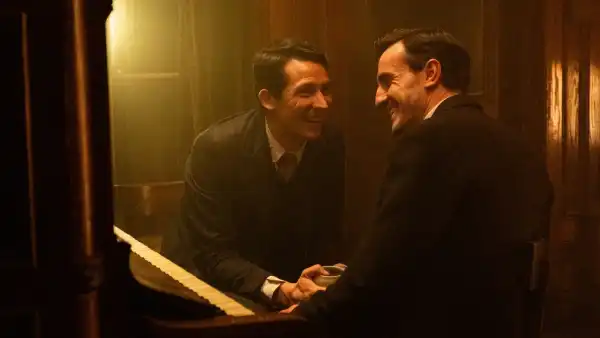
Save this storySave this storySave this storySave this story
In “The History of Sound,” a recent love story situated in the epoch of the Great War and its aftermath, ardor is an intensely intimate matter, and that is true on levels you might not anticipate. Love and longing aren’t only shown in the flushed vitality of bodies entwined; the pair of protagonists is stirred, and united, by instants of hushed, consonant accord, stemming from linked traits of heightened sensibility, refined judgment, and expert insight. An important opening scene unfolds in 1917, with Lionel Worthing (Paul Mescal), a vocal student at the New England Conservatory, enjoying drinks with acquaintances. Without warning, amidst plumes of cigarette smoke and chatter, he picks up a tune he knows: “Across the Rocky Mountain,” a vintage folk song he absorbed as a child on a Kentucky farm. It’s hardly a song one hears daily in a Boston bar, and Lionel feels an instant fascination with the singer: David White (Josh O’Connor), a fellow conservatory student.
What follows is essentially a case of love at first hearing. Here are two young men forming a bond through their shared love of American folk music, which, originating in rustic oral traditions outside their academic world, appears stuck in obscurity. David, graced with O’Connor’s impish, playful grin, is quick-witted and good at juggling tasks: he can perform a song, tickle the ivories, and hold a cigarette with roguish charm. Lionel is more timid and restrained, but Mescal—gazing through delicate, owlish spectacles that serve to simultaneously obscure and amplify his appeal—uses the character’s quiet nature to powerful effect. When Lionel, lightheartedly urged by David, sings “Silver Dagger,” a folk song about a young lady trying to heed her mother’s advice against men, his voice resonates in the smoky, now quieted tavern with a clarity that borders on the divine.
Lionel’s talent for singing is one of two abilities he has honed since childhood. The other is that Lionel possesses the capacity to visualize sound. In an initial voice-over, an older iteration of Lionel, embodied by Chris Cooper, voices his shock at realizing how few others share this gift. “I assumed everybody could visualize sound. Yellow for D,” he states. “Also taste. When my father played a B-minor, my mouth would grow bitter.” For the majority of us, sound is unseen, and the movie implies that Lionel and David’s prompt mutual allure is also essentially unseen—except, possibly, to the select few tuned to that particular frequency. As the pair fall into bed, and enter into a physically, emotionally, and intellectually charged love affair, it’s as if their passion for music, an essentially isolating endeavor, had somehow safeguarded them against the perils of social judgment. It isn’t that their love is unmentionable; rather, hardly anyone would place it if mentioned, or even start to comprehend the lingo.
While Lionel’s experience of sound is never named on screen, he is experiencing what is generally called synesthesia, where certain stimuli trigger multiple sensory reactions. (The New Yorker’s Robin Wright, drawing from her own experiences, has depicted the situation as “a kind of neurological crosstalk.”) Numerous films have hinted at the experience of synesthesia, whether by accident or through a planned attempt to mimic its effects. In the 1940 Walt Disney classic “Fantasia,” a team of animators sought out visual correlates for the forms of classical music—mainly utilizing plain narrative visual language, but also with imaginative bursts of pure abstraction. Paul Thomas Anderson’s “Punch-Drunk Love,” from 2002, integrates lyrical breaks in which a chromatic band occupies the screen, with each swelling note of Jon Brion’s soundtrack seeming to equate to a different shade.
In “The History of Sound,” the South African director Oliver Hermanus demonstrates minimal eagerness for such striking displays of cinematic expressionism. The picture has a simple, icy allure. Its most potent compositions feature forests and farms, which the cinematographer Alexander Dynan films in a wintry, desaturated style marked by pale grays and dry browns. If strong or vibrant hues exist, they remain locked inside Lionel’s mind—a vault that, voice-over excerpts aside, Hermanus intends to keep mostly sealed. His restraint extends to the portrayal of David and Lionel’s liaison. The men’s initial experience of intimacy contains some funny foreplay—David, a natural prankster, ejects a stream of water at Lionel’s face—and an almost professional suggestion (“Come on”), succeeded by a brief, tasteful transition to the following morning.
There is minimal sense of doubt, threat, or peril, which is initially enlivening; you perceive that Hermanus seeks for his characters to live and love, at least in the moment, without apprehension. However, the romance also unfolds with an unusual lack of sensory exploration and all-encompassing intensity—and surely without the pyrotechnics that defined O’Connor’s work in “God’s Own Country” (2017) or Mescal’s role in “All of Us Strangers” (2023), to mention a couple of deeply affecting gay romances of lasting emotional significance. In “The History of Sound,” David and Lionel fall into and out of each other’s embrace with an almost obligatory brevity, as if even the peaks of their amorous joy were a sensation too particular and refined for the audience to share. In time, the First World War brings their conservatory studies and their connection to a sudden conclusion: David is drafted and sent overseas, while Lionel, spared due to his poor vision, goes back to Kentucky to aid his parents (Raphael Sbarge and Molly Price) in maintaining the family farm. Yet even here, the pain of the lovers’ parting is felt with only a suppressed trace of sorrow. The camera holds us at a distance, observing.
When “The History of Sound” was released, earlier this year, at Cannes, critics drew comparisons, mainly negative, to “Brokeback Mountain,” Ang Lee’s drama from 2005. These links might ultimately reveal less about any weaknesses in Hermanus’s picture than they do about the continuing importance of Lee’s, as well as the disheartening dearth of another high-profile gay romance with similar cultural weight. Nevertheless, it’s clear what inspired these parallels. Setting aside the most obvious similarities, both pictures stand as examples of skillful narrative expansion: “Brokeback Mountain” sprang from an Annie Proulx short story, while “The History of Sound” was adapted, by Ben Shattuck, from his own short story bearing the same title. Both movies sparked interest by enlisting two celebrated and favored male actors in leading romantic roles; in the case of Hermanus’s film, the collaboration of Mescal and O’Connor brought fresh attention to a long-running but increasingly debated practice: straight performers depicting queer individuals—a point that Heath Ledger and Jake Gyllenhaal, the stars of “Brokeback Mountain,” did not have to address to the same extent.
What joins the two films, in a deeper sense, is their perception of love as an emotion that can be most thoroughly expressed, experienced, perfected, and freed in the natural world, away from society’s critical gaze. In 1919, David, returned from the war and instructing in Maine, asks Lionel to accompany him that winter on a university-sponsored research initiative to gather folk songs. Consequently, they start traversing the Maine woods on foot, using an Edison phonograph alongside a set of wax cylinders in order to preserve the sounds and songs encountered en route.
The recording scenes stand among the film’s most striking, attuned both to the impact of the music and the strange, reverent intimacy that may suddenly materialize between strangers. A particularly poignant encounter occurs on Malaga Island, in a community of formerly enslaved people where David and Lionel tape a young woman, Thankful Mary Swain (Brianna Middleton), singing the hymn “Here in the Vineyard.” It’s a song about refuge, and its loveliness strikes a severely ironic note, since the people of Malaga are on the verge of being evicted by Maine’s avaricious governor. (Historically, this forced removal occurred somewhat earlier, in 1912.)
The young men’s inability to prevent this injustice sparks a brief discord between them, and despite the fact that the removal occurs outside the frame, the reference to anti-Black violence is not an inconsequential detail. Hermanus, aged forty-two, was raised in Cape Town, in a racially mixed family that confronted and challenged apartheid. An awareness of racial and sexual injustice has colored previous pieces of his: in “Beauty” (2011), a middle-aged husband and father’s hidden desires erupt into horrific violence; “Moffie” (2021) is a story about a gay South African youth undergoing mandatory military service in the early nineteen-eighties. In both projects, using unblinking observational precision, Hermanus exposed the entangled prejudices of the apartheid era, taking on homophobia and white supremacy as expressions of the same oppression.
Following that arrived the considerable departure of “Living” (2022), a reimagining of “Ikiru,” Akira Kurosawa’s 1952 masterpiece concerning a long-serving bureaucrat committed to taking full advantage of his remaining days. In some respects, that comes across as a more faithful companion to the new film than do Hermanus’s earlier stories of agonized queer desire. The spiritual and philosophical concepts that “Living” raises—regarding the fundamental privacy of a man’s life, and the difficulty of deciding how to use the time given to us—cast a tragic shadow over David, who sustained trauma during childhood and suffers greater agony during the war. They also preoccupy Lionel, who, after the Maine expedition ends, is once again unhappily separated from David and begins to let himself drift. He spends time briefly in Rome and Oxford, where esteemed musical posts and appealing romantic chances await, but none of these can come close to the sense of professional and emotional fulfillment he felt during his song-collecting venture with David.
Mescal filmed this picture directly after “Gladiator II,” and, to his credit, there isn’t even a hint of the spiteful muscleman in his performance. Lionel might lack romantic intensity somewhat, but Mescal’s kindly attentiveness and pensive tranquility give the character an amiable presence, even as the filmmaking ultimately falls prey to inertia and the key, defining passion of Lionel’s life fades into the haze of the past. Then again, a kind interpretation of “The History of Sound” might suggest that the movie is essentially memory, and that it has been veiled in such haze from the outset. This could account for why Lionel’s experiences, as we watch them play out, already read like beautiful but understated recollections—carefully staged for the camera and, despite all of Lionel’s synesthesia, devoid of their sensory immediacy. ♦
Sourse: newyorker.com







